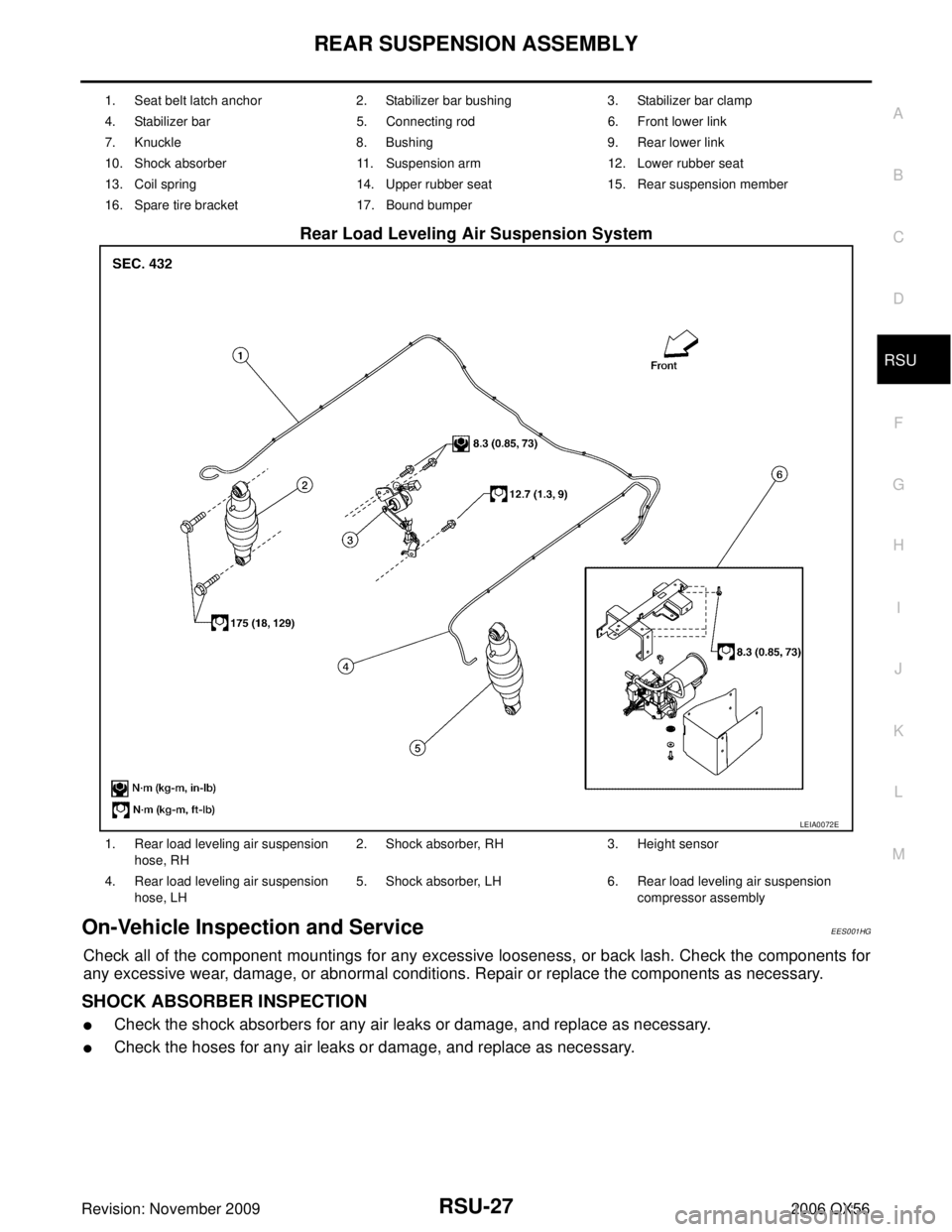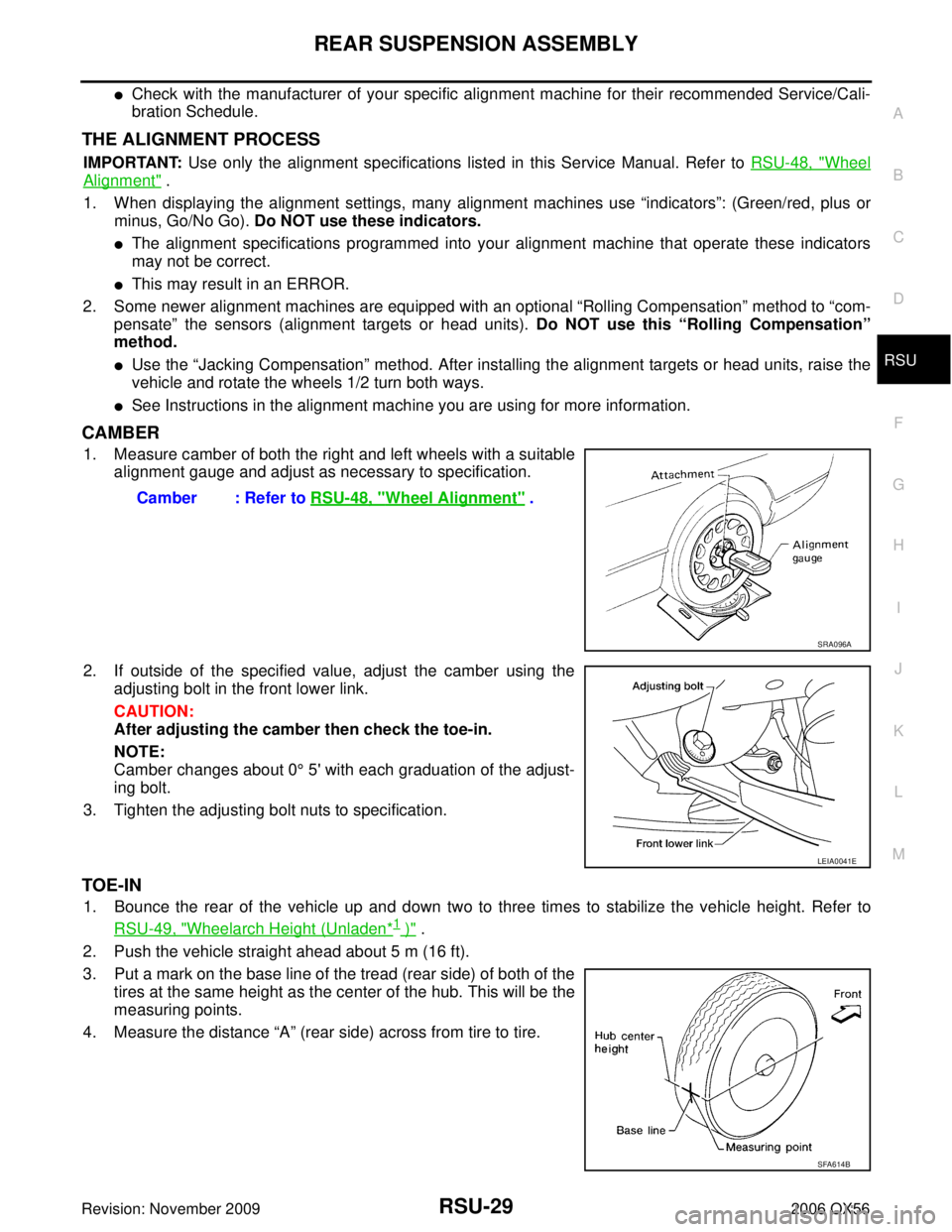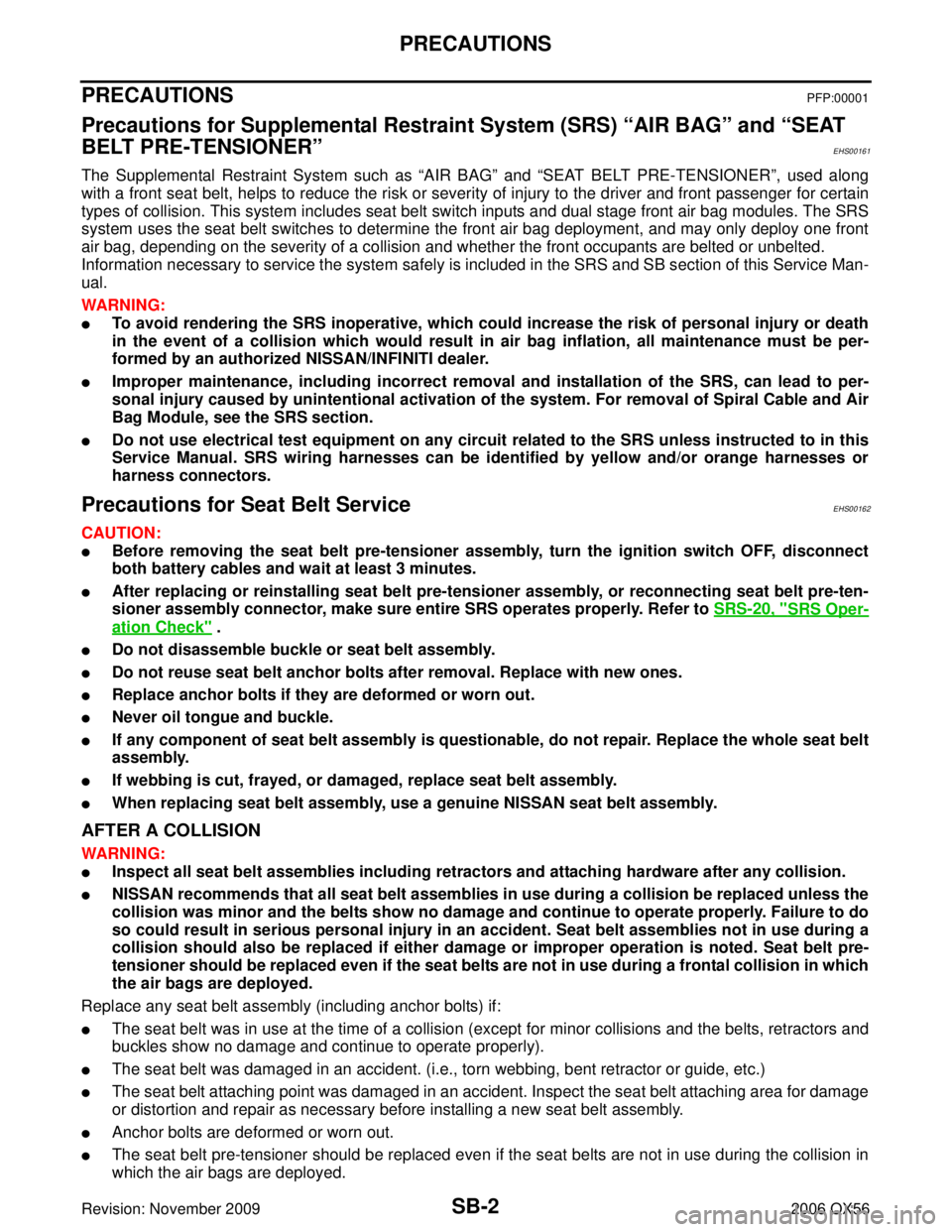Page 2866 of 3383

REAR SUSPENSION ASSEMBLYRSU-27
C
DF
G H
I
J
K L
M A
B
RSU
Revision: November 2009 2006 QX56
Rear Load Leveling Air Suspension System
On-Vehicle Inspection and ServiceEES001HG
Check all of the component mountings for any excessive looseness, or back lash. Check the components for
any excessive wear, damage, or abnormal conditions. Repair or replace the components as necessary.
SHOCK ABSORBER INSPECTION
�Check the shock absorbers for any air leaks or damage, and replace as necessary.
�Check the hoses for any air leaks or damage, and replace as necessary.
1. Seat belt latch anchor2. Stabilizer bar bushing3. Stabilizer bar clamp
4. Stabilizer bar 5. Connecting rod6. Front lower link
7. Knuckle 8. Bushing9. Rear lower link
10. Shock absorber 11. Suspension arm12. Lower rubber seat
13. Coil spring 14. Upper rubber seat15. Rear suspension member
16. Spare tire bracket 17. Bound bumper
LEIA0072E
1. Rear load leveling air suspension
hose, RH 2. Shock absorber, RH 3. Height sensor
4. Rear load leveling air suspension hose, LH 5. Shock absorber, LH
6. Rear load leveling air suspension
compressor assembly
Page 2868 of 3383

REAR SUSPENSION ASSEMBLYRSU-29
C
DF
G H
I
J
K L
M A
B
RSU
Revision: November 2009 2006 QX56
�Check with the manufacturer of your specific alignment machine for their recommended Service/Cali-
bration Schedule.
THE ALIGNMENT PROCESS
IMPORTANT: Use only the alignment specifications listed in this Service Manual. Refer to RSU-48, "Wheel
Alignment" .
1. When displaying the alignment settings, many alignment machines use “indicators”: (Green/red, plus or
minus, Go/No Go). Do NOT use these indicators.
�The alignment specifications programmed into your alignment machine that operate these indicators
may not be correct.
�This may result in an ERROR.
2. Some newer alignment machines are equipped with an optional “Rolling Compensation” method to “com-
pensate ” the sensors (alignment targets or head units). Do NOT use this “Rolling Compensation”
method.
�Use the “Jacking Compensation ” method. After installing the alignment targets or head units, raise the
vehicle and rotate the wheels 1/2 turn both ways.
�See Instructions in the alignment machine you are using for more information.
CAMBER
1. Measure camber of both the right and left wheels with a suitable alignment gauge and adjust as necessary to specification.
2. If outside of the specified value, adjust the camber using the adjusting bolt in the front lower link.
CAUTION:
After adjusting the camber then check the toe-in.
NOTE:
Camber changes about 0 ° 5' with each graduation of the adjust-
ing bolt.
3. Tighten the adjusting bolt nuts to specification.
TOE-IN
1. Bounce the rear of the vehicle up and down two to three times to stabilize the vehicle height. Refer to RSU-49, "
Wheelarch Height (Unladen*1 )" .
2. Push the vehicle straight ahead about 5 m (16 ft).
3. Put a mark on the base line of the tread (rear side) of both of the tires at the same height as the center of the hub. This will be the
measuring points.
4. Measure the distance “A” (rear side) across from tire to tire.
Camber : Refer to
RSU-48, "
Wheel Alignment" .
SRA096A
LEIA0041E
SFA614B
Page 2887 of 3383
RSU-48
SERVICE DATA AND SPECIFICATIONS (SDS)
Revision: November 20092006 QX56
SERVICE DATA AND SPECIFICATIONS (SDS)PFP:00030
Wheel AlignmentEES001HT
Ball JointEES001HU
Camber
Degree minute (decimal degree)Minimum
0° 0 ′ (0 °)
Nominal - 0° 30 ′ (-0.5 °)
Maximum - 1° 0 ′ (-1.0 °)
Cross camber 0° 45′ (0.75 °)
Toe-in Distance (A - B)
Minimum
0 mm (0 in)
Nominal 3.3 mm (0.130 in)
Maximum 6.6 mm (0.260 in)
Cross toe 2 mm (0.079 in)
Angle (left, right)
Degree minute (decimal degree) Minimum
0° 0 ′ (0 °)
Nominal 0° 7 ′ (0.11 °)
Maximum 0° 14′ (0.22 °)
Cross toe 0° 8 ′ (0.14 °)
SFA234AC
Swinging force (measurement point: cotter pin hole of ball stud) “A ” 11.4 - 145.5 N (1.16 - 14.8 kg, 2.56 - 32.7 lb)
Turning torque “B ” 0.5 - 6.4 N·m (0.06 - 0.65 kg-m, 5 - 56 in-lb)
Vertical end play “C ” 0 mm (0 in)
SFA858A
Page 2888 of 3383
SERVICE DATA AND SPECIFICATIONS (SDS)RSU-49
C
DF
G H
I
J
K L
M A
B
RSU
Revision: November 2009 2006 QX56
Wheelarch Height (Unladen*1 )EES001HV
Unit: mm (in)
*1: Fuel, engine coolant and engine oil full. Spare tire, jack, hand tools and mats in designated positions.
*2: Verify the vehicle height. If vehicle height is not within ± 10 mm (0.39 in) of the specification, perform the control unit initialization pro-
cedure. Refer to RSU-47, "
Initialization Procedure" .
Suspension type
Air leveling*
2
Applied model2WD 4WD
Front wheelarch height (Hf) 913
(35.94) 931
(36.65)
Rear wheelarch height (Hr) 912
(35.91) 932
(36.69)
LEIA0085E
Page 2889 of 3383
RSU-50
SERVICE DATA AND SPECIFICATIONS (SDS)
Revision: November 20092006 QX56
Page 2890 of 3383

SB-1
SEAT BELTS
H RESTRAINTS
CONTENTS
C
DE
F
G
I
J
K L
M
SECTION
A
B
SB
Revision: November 2009 2006 QX56
PRECAUTIONS .....................................................
..... 2
Precautions for Supplemental Restraint System
(SRS) “AIR BAG” and “SEAT BELT PRE-TEN-
SIONER” ............................................................. ..... 2
Precautions for Seat Belt Service ....................... ..... 2
AFTER A COLLISION ...................................... ..... 2
SEAT BELTS ......................................................... ..... 3
Removal and Installation of Front Seat Belt ........ ..... 3
FRONT SEAT BELT RETRACTOR .................. ..... 4
FRONT SEAT BELT BUCKLE .......................... ..... 5
Removal and Installation of Second Row Seat Belt ..... 6
REMOVAL ........................................................ ..... 7
INSTALLATION ................................................ ..... 7
SECOND ROW SEAT BELT BUCKLE ............. ..... 7
SECOND ROW SEAT BELT RETRACTOR -
BENCH SEAT .................................................. ..... 7
Removal and Installation of Third Row Seat Belt ..... 8 REMOVAL ........................................................
..... 8
INSTALLATION ................................................ ..... 9
REMOVAL ........................................................ ..... 9
INSTALLATION ................................................ ..... 9
THIRD ROW SEAT BELT BUCKLE ................. ..... 9
Seat Belt Inspection ............................................. ... 11
AFTER A COLLISION ...................................... ... 11
PRELIMINARY CHECKS ................................. ... 11
SEAT BELT RETRACTOR ON-VEHICLE
CHECK ............................................................. ... 12
SEAT BELT RETRACTOR OFF-VEHICLE
CHECK ............................................................. ... 12
LATCH (LOWER ANCHORS AND TETHER FOR
CHILDREN) SYSTEM ............................................ ... 14
Removal and Installation ..................................... ... 14
TOP TETHER STRAP CHILD RESTRAINT .......... ... 15
Removal and Installation ..................................... ... 15
Page 2891 of 3383

SB-2
PRECAUTIONS
Revision: November 20092006 QX56
PRECAUTIONSPFP:00001
Precautions for Supplemental Restraint System (SRS) “AIR BAG” and “SEAT
BELT PRE-TENSIONER”
EHS00161
The Supplemental Restraint System such as “AIR BAG” and “SEAT BELT PRE-TENSIONER ”, used along
with a front seat belt, helps to reduce the risk or severity of injury to the driver and front passenger for certain
types of collision. This system includes seat belt switch inputs and dual stage front air bag modules. The SRS
system uses the seat belt switches to determine the front air bag deployment, and may only deploy one front
air bag, depending on the severity of a collision and whether the front occupants are belted or unbelted.
Information necessary to service the system safely is included in the SRS and SB section of this Service Man-
ual.
WARNING:
�To avoid rendering the SRS inoperative, which could increase the risk of personal injury or death
in the event of a collision which would result in air bag inflation, all maintenance must be per-
formed by an authorized NISSAN/INFINITI dealer.
�Improper maintenance, including incorrect removal and installation of the SRS, can lead to per-
sonal injury caused by unintentional activation of the system. For removal of Spiral Cable and Air
Bag Module, see the SRS section.
�Do not use electrical test equipment on any circuit related to the SRS unless instructed to in this
Service Manual. SRS wiring harnesses can be identified by yellow and/or orange harnesses or
harness connectors.
Precautions for Seat Belt ServiceEHS00162
CAUTION:
�Before removing the seat belt pre-tensioner assembly, turn the ignition switch OFF, disconnect
both battery cables and wait at least 3 minutes.
�After replacing or reinstalling seat belt pre-tensioner assembly, or reconnecting seat belt pre-ten-
sioner assembly connector, make sure entire SRS operates properly. Refer to SRS-20, "
SRS Oper-
ation Check" .
�Do not disassemble buckle or seat belt assembly.
�Do not reuse seat belt anchor bolts after removal. Replace with new ones.
�Replace anchor bolts if they are deformed or worn out.
�Never oil tongue and buckle.
�If any component of seat belt assembly is questionable, do not repair. Replace the whole seat belt
assembly.
�If webbing is cut, frayed, or damaged, replace seat belt assembly.
�When replacing seat belt assembly, use a genuine NISSAN seat belt assembly.
AFTER A COLLISION
WARNING:
�Inspect all seat belt assemblies including retractors and attaching hardware after any collision.
�NISSAN recommends that all seat belt assemblies in use during a collision be replaced unless the
collision was minor and the belts show no damage and continue to operate properly. Failure to do
so could result in serious personal injury in an accident. Seat belt assemblies not in use during a
collision should also be replaced if either damage or improper operation is noted. Seat belt pre-
tensioner should be replaced even if the seat belts are not in use during a frontal collision in which
the air bags are deployed.
Replace any seat belt assembly (including anchor bolts) if:
�The seat belt was in use at the time of a collision (except for minor collisions and the belts, retractors and
buckles show no damage and continue to operate properly).
�The seat belt was damaged in an accident. (i.e., torn webbing, bent retractor or guide, etc.)
�The seat belt attaching point was damaged in an accident. Inspect the seat belt attaching area for damage
or distortion and repair as necessary before installing a new seat belt assembly.
�Anchor bolts are deformed or worn out.
�The seat belt pre-tensioner should be replaced even if the seat belts are not in use during the collision in
which the air bags are deployed.
Page 2903 of 3383
SB-14
LATCH (LOWER ANCHORS AND TETHER FOR CHILDREN) SYSTEM
Revision: November 20092006 QX56
LATCH (LOWER ANCHORS AND TETHER FOR CHILDREN) SYSTEMPFP:75466
Removal and InstallationEHS00168
NOTE:
The LATCH (Lower Anchors and Tether for Children) system is not serviceable.